Author's note: The size and destruction of the Camp Fire grew significantly since this article was originally published. Now that this record-breaking fire has been fully contained, I've updated the charts and article to show its shocking "off-the-charts" scale.
California is on the burning edge of climate breakdown. Record-breaking drought and heat have turned the Golden State into a tinderbox. The megafires have followed. In the last two years a string of off-the-chart wildfires have exploded with stunning speed and ferocity across forests, grasslands, rural areas and city neighborhoods. California Governor Jerry Brown has called it "the new abnormal."
To illustrate this new abnormal, I’ve charted California’s biggest and most destructive wildfires since modern records started being kept around 1930.
Top 20 largest wildfires
Let’s start by looking at the state's list of top-20 largest fires.
My chart below arranges them by year. The height of each bar shows the number of acres burned. The red bars are the fires from 2017 and 2018.
Two things jump out.
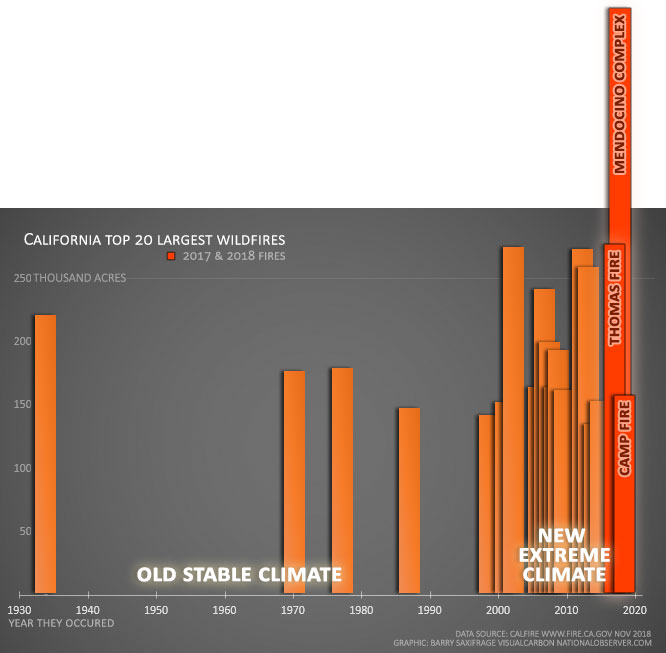
First, you can see that California's megafires are becoming much more frequent. These gigantic fires used to be rare events. Now Californians are struggling against them with dizzying frequency.
Second, you can see how they suddenly leap off-the-charts in scale.
Less than a year ago I wrote about 2017's freakish Thomas Fire. It not only became California's chart-topping wildfire, it did it during the month of December during California's "rainy season." It was the first “rainy season” fire to burn its way into the top-20.
Just seven months later, in July 2018, the Mendocino Complex fire exploded out of control. By the time an armada of fire fighters, bulldozers, tankers and water bombers could put it out, more than 450,000 acres had burned — sixty per cent more than the old record.
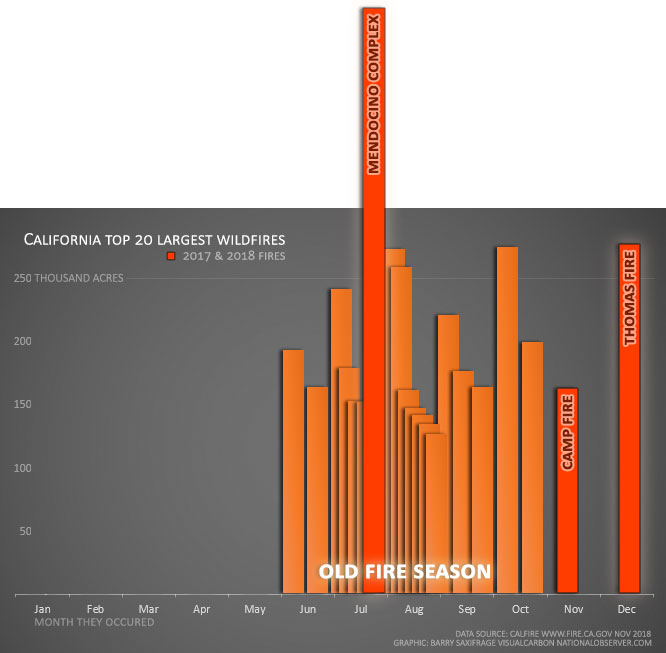
A few months after that, In November 2018, the Camp Fire burned more than 153,000 acres.
It joins the Thomas Fire as the second "rainy season" fire to break into the top-20 largest.
Here are the same top-20 fires arranged by the month of the year they occurred.
As you can see, California's megafire season is spilling out of its "old normal" boundaries.
Top 20 most destructive wildfires
Now let's look at the state's top-20 most-destructive fires. As before, my chart below arranges these by the year they occurred. In this case, the height of each bar shows the number of structures destroyed. The fires from 2017 and 2018 are highlighted in red.
The same two troubling patterns jump out here as well.
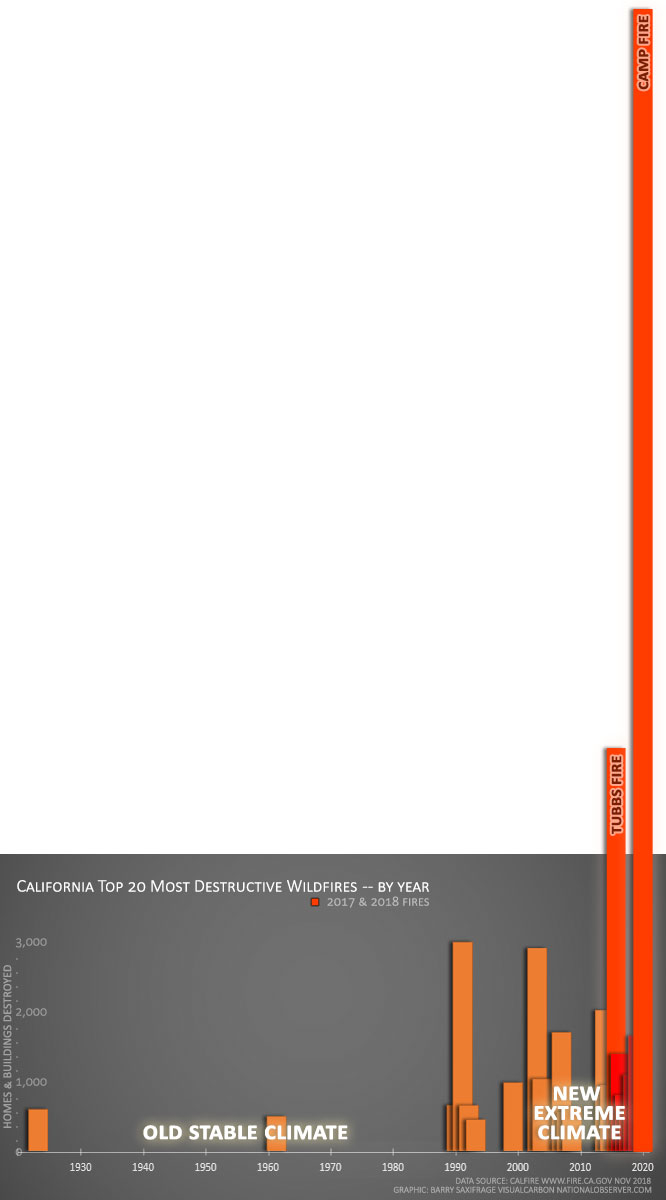
First, you can see that these destructive megafires are becoming much more frequent and much more extreme.
For example, seven of these top-20 destructive fires happened in the last two years (red bars).
The second similar pattern is the recent off-the-charts leap in scale.
Take a look at the red bar showing the destruction from the Tubbs Fire. This megafire ripped through Napa and Sonoma counties in October of 2017. Before thousands of firefighters working 24-hour shifts could put it out, over 5,600 homes and buildings were destroyed. That didn't just break the previous record for destruction — it nearly doubled it.
While that was literally off-the-charts, far worse was on the horizon.
In the following year, six more megafires burned their way onto California's most destructive top-20 list.
And the most recent of these was the monstrous Camp Fire in Butte county. It started on November 8, 2018. Within 36 hours it had exploded with such speed and fury that it had already destroyed more homes and buildings than the previous never-seen-anything-like-this Tubbs Fire did in total. When the Camp Fire was finally contained, more than 14,000 homes, 500 commercial buildings and 4,000 other structures had burned down.
The Camp Fire also killed more people than any other American fire in the age of modern firefighting, weather forecasting and rapid communication.
Hotter and drier
The largest and most destructive wildfires in California have occurred when the conditions are both exceptionally hot and dry. Sadly, such hot & dry years have become both more common and more extreme.
To illustrate this trend, my next chart shows the average temperature and precipitation for all of California's wildfire seasons since 1895. (NOAA data with h/t to @RARohde)

Grey circles show all the years before 2000. Coloured dots show the years since. Red indicates 2017 and 2018.
The first thing to note is that every fire year in the new millennium has been hotter than average. Even more troubling, many of these were hotter than any fire season in the past century.
You can also see that most of the fire seasons since 2000 have been drier than the "old normal."
Several years have jumped up to a whole new level of "hotter & drier" — note the red dots for 2017 and 2018. As we saw above, both years witnessed a whole new level of extreme fires as well.
There will always be both natural lightning strikes and human-caused sparks to start fires in California. But to turn a common brush fire into a city-eating megafire requires a lot of kindling-dry fuel (forests, brush, grassland) that is capable of burning explosively. Hot and dry years do just that.
The new abnormal
Now that some of the first big, unmistakable, climate impacts have started to hit home in recent years, commentators often refer to these events as a “new normal.” If only we were that lucky. The word “normal” implies a new predictable plateau that we can get used to. Something different but ultimately … “normal.”
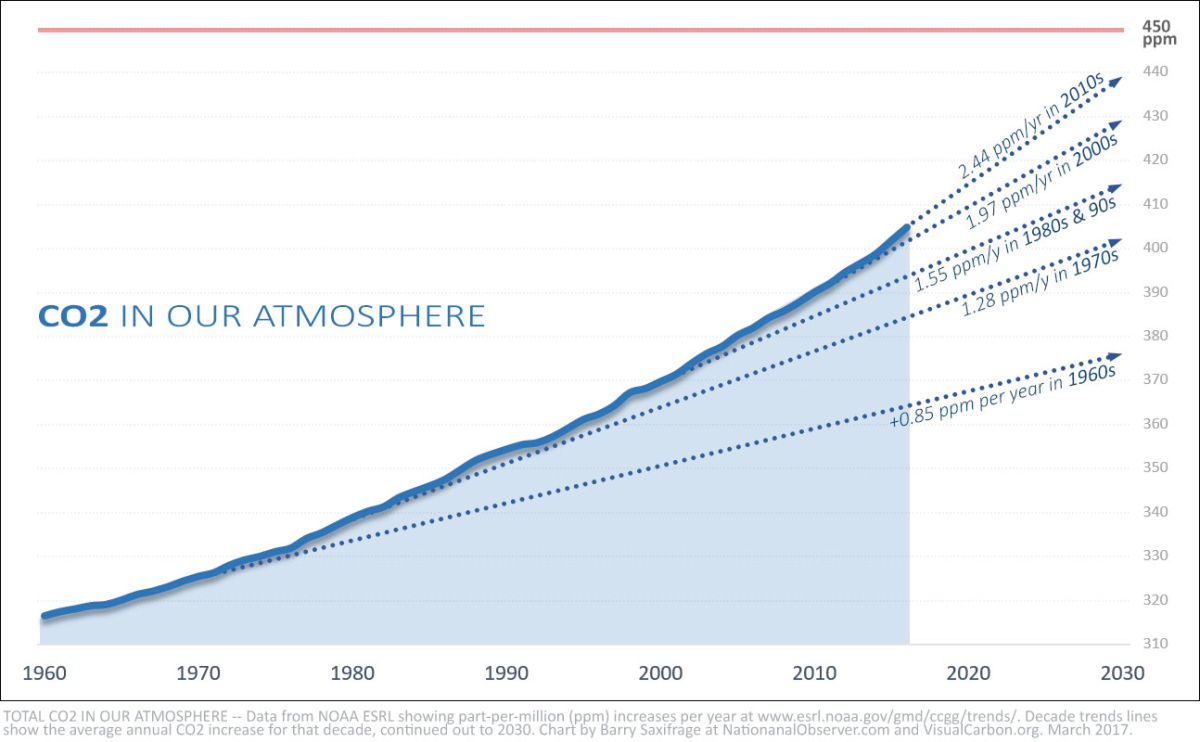
That is not what is happening. As long as humanity continues dumping billions of tonnes of climate pollution into the air and water each year, climate breakdown will continue to accelerate into an ever more extreme and unpredictable future.
As three scientists explained earlier this year in the Guardian: “California’s governor, Jerry Brown, has characterized these devastating wildfires as California’s “new normal.” But it would be a mistake to assume that the region has reached any semblance of a stable plateau. Instead, the likelihood of large, fast-moving, and dangerous wildfires will continue to increase in the coming decades....”
That was last year. After yet another off-the-charts fire year, Governor Brown is now more clear about what’s unfolding: “This is not the new normal. This is the new abnormal … Unfortunately, the best science is telling us that dryness, warmth, drought, all those things, they’re going to intensify … We have a real challenge here threatening our whole way of life...”
How “abnormal” could it get in the Golden State?
I remember vividly a winter day, back in 2009, when U.S. Secretary of Energy Steven Chu, a Nobel Prize-winning physicist, voiced his deep concerns for what climate change could do his home state: "I don't think the American public has gripped in its gut what could happen … We're looking at a scenario where there's no more agriculture in California." And, he added, "I don't actually see how they can keep their cities going."




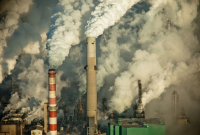

Comments
Quite an outstanding article- and such a relief from the evasions of the mainstream Canadian media, including CBC online News. Readers might like to read an article by Laura Parker in the National Geographic online on American kids suing the state over the issue of climate change in their futures.
Trump says rake the forest floor like they do in Finland. Finnish citizens respond with the hashtag ``rake America great again.`` They don't actually rake the forest floor in Finland and they do have forest fires.
Ah, he's such a gigantic idiot. Words fail.
Graphs put the damage and carnage in a better perspective. It's past the time for governments to debate climate change or no climate change.
Some time ago a columnist took a crack at graphing the overall impact on the environment. The article included a cradle to grave approach from the time we start mining raw material to the consumption of the finished product. I would like to see that article published again with current statistics included. We need to attach the environmental issues on all fronts with meaningful effort on the part of all governments and citizens. This peace meal approach is not working. Every citizen needs to do their part to stop the damage we as humans are doing to the environment we live in.
Excellent work. Thx
"We're looking at a scenario where there's no more agriculture in California." Think about what that means. Think about how much California produce gets exported. We could be looking at famine, maybe a lot sooner than expected.
I'll say one thing. The urban vegan lifestyle that promises a saved planet if we cease to eat any meat is going to have to wake up to where their almond milk comes from. While consciousness is rising, we could also do some graphs on how much water almond trees require, compare the nutritional values of milk and almond milk....and start asking ourselves about our own food resilience. Turnip juice anyone?
And once we're done calculating our Canadian food security, we could spare a thought for how we're going to integrate all those climate refugees coming from California to our borders....because we'd better face it now.
They will be looking for greener pastures...orchards....and arable acres. Is there some compassionate way to screen out the Republicans? Something to think about.
Please also read my own recent story - "Humanity Sleepwalks as Earth Burns." https://www.planetinperil.ca/2018/11/humanity-sleepwalks-as-earth-burns…